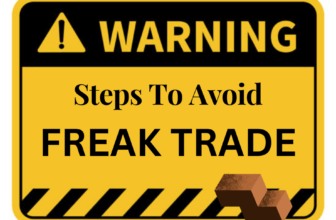Swing trading is a style of trading that is designed to capitalize on short-term price movements in a stock. Swing traders attempt to identify the beginning of a price trend and hold on to the position until the trend shows signs of reversing. Swing traders may hold their positions for a few hours to several days, depending on the asset and market conditions. While swing trading is not suitable for all investors, it can be a profitable trading strategy for those who have the discipline and patience to follow it. Swing Trading is a little easier than Intraday trading. And is ideal for working professionals, students, and housewives
Here are 5 Tips for Swing Traders:
1. Set a Risk/Reward Ratio:
Risk/reward is one of the most important elements of trading. Before entering any trade, swing traders should set a risk/reward ratio that is acceptable to them. This ratio will determine the size of the position they take, as well as the potential reward that can be earned. For example, a risk/reward ratio of 1:2 means that the trader is willing to risk one unit of currency in order to make two units of profit.
2. Identify an Entry Point:
Once a risk/reward ratio has been set, swing traders must identify an entry point. This is the price at which they believe the asset will begin to move in the desired direction. It is important to note that the entry point should be based on technical analysis, not fundamentals.
3. Monitor the Market:
Once an entry point has been identified, swing traders should monitor the market closely to ensure that the stock begins to move in the desired direction. This can be done by watching the daily chart of the asset, as well as the news surrounding the stock.
4. Set a Target Price:
Once a target price has been set, swing traders should set a limit order to exit the position. This will ensure that the position is closed out once the target price has been reached.
5. Manage Risk:
Finally, swing traders must manage their risk. This can be done by using stop losses and trailing stops to minimize losses. Additionally, swing traders should never risk more than they can afford to lose.
What are the top 5 Indicators for swing traders?
1. Moving Averages:
Moving averages are among the most popular technical indicators used by swing traders. Moving averages are used to identify the direction of a trend by smoothing out short-term price movements. The most popular moving average is the 20-day moving average, which is used to identify the overall trend.
2. Relative Strength Index (RSI):
The Relative Strength Index (RSI) is another popular indicator used by swing traders. The RSI is a momentum indicator that measures the magnitude and velocity of price movements over a specified period of time. The RSI is used to determine whether the stock is overbought or oversold.
3. Bollinger Bands:
Bollinger Bands are volatility bands that are placed above and below a moving average. The bands expand when the market is volatile, and contract when the market is range-bound. Swing traders use the bands to identify potential entry and exit points.
4. Stochastics:
Stochastics are momentum indicators that measure the speed and magnitude of price movements. The indicator is used to identify overbought and oversold conditions.
5. Volume:
Volume is the number of shares or contracts that are traded in a particular security over a given period of time. Volume is used to measure the strength of a trend. If the volume increases during an uptrend, it is an indication that the trend is strong. If the volume decreases during a downtrend, it is an indication that the trend is weak.
In conclusion, swing trading is a popular trading strategy that is designed to capitalize on short-term price movements. Swing traders should set a risk/reward ratio, identify an entry point, monitor the market, set a target price, and manage their risk in order to increase their chances of success. Additionally, swing traders should also be familiar with the top 5 indicators for swing trading, which are moving averages, relative strength index (RSI), Bollinger Bands, Stochastics, and volume. With discipline and patience, swing trading can be a profitable trading strategy for those who are willing to put in the time and effort to learn the strategy.







